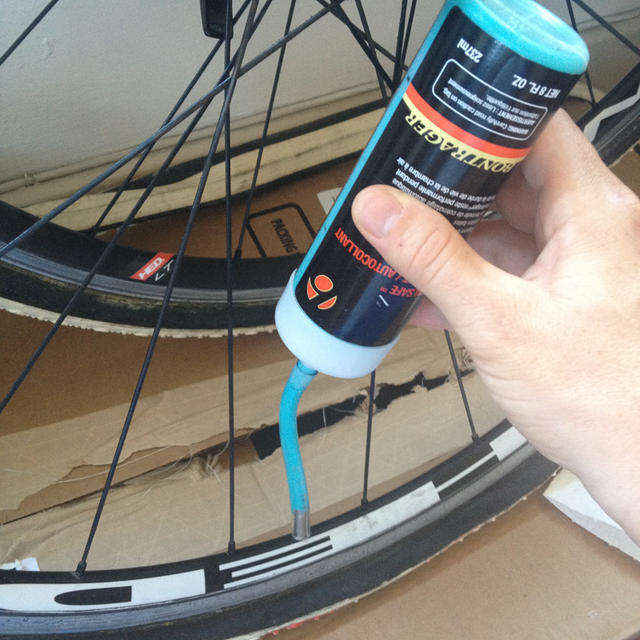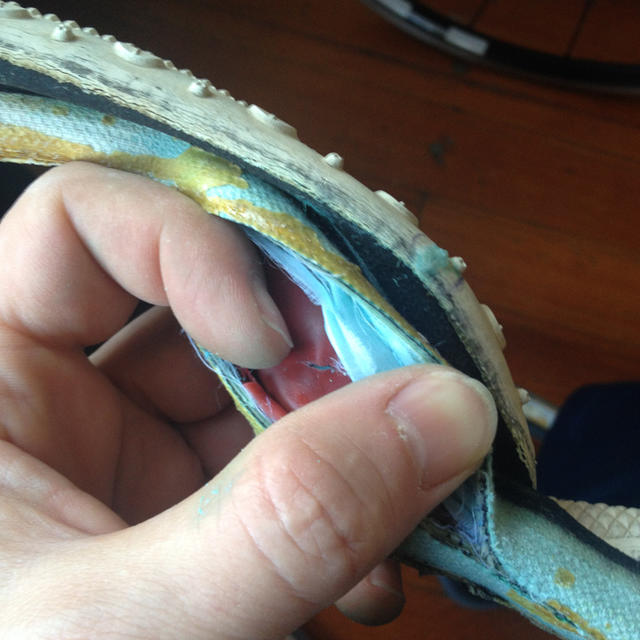Training on tubulars, bad idea?
Posted December 30, 2015 01:21PM by
Skye in the
Cycling Forum
I've been riding around on my cross bike a lot this winter, it's become my bad weather bike, and it's currently outfitted with 33mm file-tread tubulars. I have to say I really enjoy the ride, at 35 psi it soaks up every bump in the road and offers loads of grip on wet leaves, road paint, and the occasional frosty or icy section of road.
As I take it for longer and longer road rides though, I am a bit worried about the lack of roadside repair options with the tubular setup. On the other hand, since these Challenge Grifo XS tires (now apparently called the Challenge Almanzo gravel tires) came with removable cores, I did fill them up with a fair bit of Bontrager Seal Safe when I first got them. The front tire had a pinhole leak when I bought them used, and it instantly stopped the leak and should offer a fair bit of protection for any future punctures up to a certain point. At this point I'm resigned to the fact that if I do get a large gash that the Sealsafe can't fill, I'll be taking a cab home.
Anyone else ride tubulars for normal riding/training? What are your experiences or advice?
Thanks,
Skye
As I take it for longer and longer road rides though, I am a bit worried about the lack of roadside repair options with the tubular setup. On the other hand, since these Challenge Grifo XS tires (now apparently called the Challenge Almanzo gravel tires) came with removable cores, I did fill them up with a fair bit of Bontrager Seal Safe when I first got them. The front tire had a pinhole leak when I bought them used, and it instantly stopped the leak and should offer a fair bit of protection for any future punctures up to a certain point. At this point I'm resigned to the fact that if I do get a large gash that the Sealsafe can't fill, I'll be taking a cab home.
Anyone else ride tubulars for normal riding/training? What are your experiences or advice?
Thanks,
Skye
Webmaster - Staminist.com
I guess I jinxed myself. Went on an epic ride a couple days ago, over ice, branches, frost, gravel, you name it. No problems at all and the non-vulcanized rubber and double puncture-protection on these tires worked perfectly, even on sheets of ice and wet 20% grades. However on the way home I took a massive hit on some debris in a "bike path" and the front tire instantly deflated.
Haven't had time to look at it yet, I didn't see any obvious tears (probably pinch flat) but the Sealsafe didn't seal it even with pumping and rotating the tire for a while. Could be that the freezing temp that day was preventing the sealant from flowing particularly well. Going to have a look at it again today and see if I can get it to hold air again. Luckily, it was only about a 30 minute walk from home!
Haven't had time to look at it yet, I didn't see any obvious tears (probably pinch flat) but the Sealsafe didn't seal it even with pumping and rotating the tire for a while. Could be that the freezing temp that day was preventing the sealant from flowing particularly well. Going to have a look at it again today and see if I can get it to hold air again. Luckily, it was only about a 30 minute walk from home!
Webmaster - Staminist.com
Since the front tubular was going in the trash anyway, I thought I would cut it open to inspect the damage, and to see how they are constructed.
After lots of grunting to peel it off the rim, I carefully sliced through the inner cotton casing with an X-acto knife but still managed to cut the very delicate latex tube. It appears the tube was glued along the inner surface, which would make it nearly impossible to open the casing without damaging the tube. I've heard stories of people taking off their tubulars after getting a flat, opening the casing, patching the tube, sewing the casing back together, and using the residual stickiness of the glue/tape on the rim as a "good enough" roadside repair to get them home. Unlikely with this construction.
Between the tire and the tube is some sort of very fine, high TPI polyester fabric. I assume this is the "SuperPoly 260 TPI casing" in the spec sheet for these Challenge Almanzo's.
Finally, the red latex tube. As suspected, the impact created a large pinch flat, too big for the Sealsafe to plug. I didn't check, but it's quite likely there's another identical cut on the opposite side of the tube, the typical "snake bike" typical of pinch flats.
So, that was an interesting experiment. The tubulars were fantastic to ride, incredibly supple and grippy while still fast rolling. However with the difficulty in repairing them, at home or at the roadside, means I'll probably be sticking to clinchers for normal riding for a while longer - and saving the tubulars for race day. I just did my first ride on some Michelin Pro4 Endurance 28mm clinchers, and they feel quite nice.
Not to mention, from an environmental and economic point of view, throwing away a $100 tire because of a flat doesn't make much sense.
After lots of grunting to peel it off the rim, I carefully sliced through the inner cotton casing with an X-acto knife but still managed to cut the very delicate latex tube. It appears the tube was glued along the inner surface, which would make it nearly impossible to open the casing without damaging the tube. I've heard stories of people taking off their tubulars after getting a flat, opening the casing, patching the tube, sewing the casing back together, and using the residual stickiness of the glue/tape on the rim as a "good enough" roadside repair to get them home. Unlikely with this construction.
Between the tire and the tube is some sort of very fine, high TPI polyester fabric. I assume this is the "SuperPoly 260 TPI casing" in the spec sheet for these Challenge Almanzo's.
Finally, the red latex tube. As suspected, the impact created a large pinch flat, too big for the Sealsafe to plug. I didn't check, but it's quite likely there's another identical cut on the opposite side of the tube, the typical "snake bike" typical of pinch flats.
So, that was an interesting experiment. The tubulars were fantastic to ride, incredibly supple and grippy while still fast rolling. However with the difficulty in repairing them, at home or at the roadside, means I'll probably be sticking to clinchers for normal riding for a while longer - and saving the tubulars for race day. I just did my first ride on some Michelin Pro4 Endurance 28mm clinchers, and they feel quite nice.
Not to mention, from an environmental and economic point of view, throwing away a $100 tire because of a flat doesn't make much sense.
Webmaster - Staminist.com




